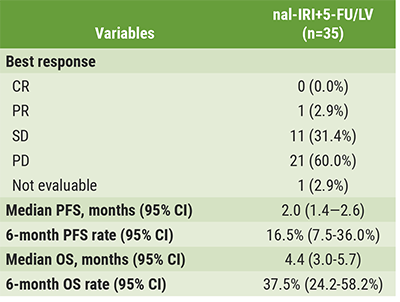Although anti-EGFR agents are active as single-therapy in RAS wildtype mCRC, only few studies are available on their role in maintenance therapy during chemotherapy-free intervals. Compared to observation, maintenance therapy with fluoropyrimidine ± bevacizumab showed significant improvement in PFS but not in overall survival (OS) in patients with unresectable mCRC and disease control after first-line doublet chemotherapy ± bevacizumab [1]. The aim of the presented multicentre, non-comparative phase 2 trial study (NCT02404935) was to compare maintenance treatment with bi-weekly cetuximab alone (arm A) or observation only (arm B) until disease progression, unacceptable toxicity, or death [2].
A total of 214 RAS wildtype unresectable mCRC patients with controlled disease after FOLFIRI + cetuximab (8 cycles) were enrolled, of which 139 were randomised (n=67 arm A, n=72 arm B). Randomisation was stratified according to tumour response, centre, baseline Köhne Score, CEA, and platelet count. In case of tumour progression during the chemotherapy-free interval, FOLFIRI + cetuximab was reintroduced for 8 cycles, followed by a new chemotherapy-free interval. Tumour response was assessed per RECIST 1.1 every 8 weeks. The primary endpoint was 6-month PFS after initiation of maintenance therapy. Secondary endpoints were overall response rate (ORR), time to strategy failure, PFS, OS, safety, quality of life, circulating tumour cells and circulating tumour DNA detection, and dynamic changes during treatment. Of the secondary endpoints, only PFS was presented.
The median follow-up was 30 months. The 6-month PFS rate was 34.3% (95% CI 23.2-46.9) in arm A and 6.9% (95% CI 2.3-15.5) in arm B. Although showing a large difference in PFS, the study did not meet its primary endpoint according to the power calculation. Evaluation of PFS as a secondary endpoint showed a median PFS during the first chemotherapy-free interval of 5.3 months in arm A and 2 months in arm B without overlap of 95% CI (see Figure).
Figure: PFS after randomisation [2]

Dr Valérie Boige (Institut Gustave Roussy, France) concluded: “Based on the study hypothesis, the cetuximab maintenance arm did not meet the primary objective. However, the clinically meaningful difference in PFS without any overlap in the confidence intervals between both arms warrants further investigation.”
- Sonbol M.B. et al. JAMA Oncol. 2020 Mar 1;6(3):e194489.
- Boige V. et al. Maintenance treatment with cetuximab versus observation in RAS wild-type metastatic colorectal cancer: Results of the randomized phase II PRODIGE 28-time UNICANCER study. ASCO Gastrointestinal Cancers Symposium 2021, 15-17 January. Abstract 15.
Copyright ©2021 Medicom Medical Publishers
Posted on
Previous Article
« Duloxetine ameliorates oxaliplatin-induced peripheral neuropathy Next Article
Yttrium-90 (Y-90) glass microspheres for HCC »
« Duloxetine ameliorates oxaliplatin-induced peripheral neuropathy Next Article
Yttrium-90 (Y-90) glass microspheres for HCC »
Related Articles

March 12, 2021
Phase 2 abemaciclib trial in patients with advanced NETs
© 2024 Medicom Medical Publishers. All rights reserved. Terms and Conditions | Privacy Policy

